

 |
Search the Site with

|
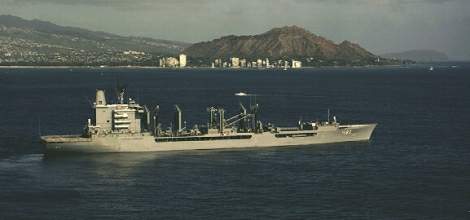 | 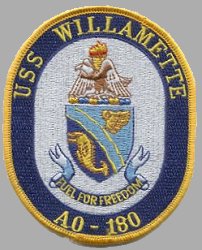 |
USS WILLAMETTE was the fourth ship in the CIMARRON - class of fleet oilers and the first ship in the Navy to bear the name. Since decommissioning the ship is laid-up at the Suisun Bay Reserve Fleet, Benicia, CA. USS WILLAMETTE was last homeported in Pearl Harbor, HI. and when the ship was commissioned in 1982, she was the first US Navy ship to be commissioned in Pearl Harbor since 1917.
On September 27, 1991, WILLAMETTE was the second ship of the CIMARRON-class to complete jumboization. A 108 foot midbody section was added to the center of the ship. This midbody increased fuel capacity by 30,000 barrels and added an ordnance cargo capability of 625 tons. The midbody also featured an additional emergency diesel generator and two standard tensioned replenishment alongside method (STREAM) cargo stations.
| General Characteristics: | Awarded: April 11, 1978 |
| Keel laid: August 4, 1980 | |
| Launched: July 18, 1981 | |
| Commissioned: December 18, 1982 | |
| Decommissioned: April 30, 1999 | |
| Builder: Avondale Shipyards, Inc., New Orleans, LA | |
| Propulsion system: two 600psi Boilers (Automated Steam) | |
| Propellers: one | |
| Length: 700 feet (213.4 meters) | |
| Beam: 88 feet (26.8 meters) | |
| Draft: 32 feet (9.7 meters) | |
| Displacement: approx. 37,000 tons | |
| Speed: 19 knots | |
| Capacity: 150,000 barrels of fuel oil or aviation fuel and several tons of additional goods | |
| Aircraft: none, but helicopter platform | |
| Armament: two | |
| Crew:15 officers and 215 enlisted |
Crew List:
This section contains the names of sailors who served aboard USS WILLAMETTE. It is no official listing but contains the names of sailors who submitted their information.
Accidents aboard USS WILLAMETTE:
| Date | Where | Events |
|---|---|---|
| February 10, 1986 | 75 miles southwest of Pearl Harbor, HI | USS WILLAMETTE collides with the USS JASON (AR 8) during a formation steaming exercise, killing one and injuring eight. The collision smashes WILLAMETTE's starboard bow from the rail to below the waterline. A large vertical rupture from deck to waterline on the port side of the JASON forces the ship to be towed back to port. |
About the Ship's Name:
The name Willamette is of Indian origin, though there is no definitive source. The name is thought to mean long and beautiful river or rainwaters along the river.
The Willamette River flows north from its source near Eugene, Oregon and empties into the Columbia river near Portland. It has at least two distinctions: it is one of the few rivers of any volume in the United States that flows in a northerly direction and it is the largest river lying wholly within one state.
The Willamette emerges into the Willamette Valley as three forks. The Coast Fork issues from a heavily forested wilderness while the Middle Fork flows from the base of Emigrant Butte in the Calapooga Hills. These tow streams join in the upper reaches of the valley. Some miles below they are joined by the third fork, the McKenzie, which rises at the base of Three Sisters in the Cascade range.
The settlement of the Oregon county began on the banks of the Willamette. Throughout the 19th century the Willamette was the focus of the civilization in Western Oregon. The abundant fish in its waters, especially salmon, and the game in its flood plains were a reliable source of food and its rich bottomlands bore heavy corps of wheat and hay.
The river was the principal means of transportation as flatboats plowed their way along the river. After 1851 they were replaced by sidewheelers and later stern-wheelers.
Through the early 20th century the river's importance declined as land and air transportation become more efficient. In recent years a successful water cleanup campaign has enhanced its natural scenic beauty and recreational resources.
The Willamette river basin contains the states three largest cities - Portland, Salem, and Eugene; approximately 70 percent of the state's population. It supports an economy based on timber, agriculture, industry, and recreation. It supplies extensive fish and wildlife habitats, as well as a source of hydroelectric power.
USS WILLAMETTE Image Gallery:
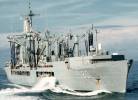 |
The photos below were taken by me and show the WILLAMETTE laid-up at Suisun Bay, Calif., on March 27, 2010.
 | 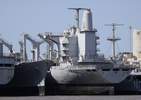 | 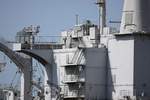 | 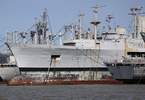 |
 Back to Fleet Oilers page.
Back to Fleet Oilers page.  Back to ships list.
Back to ships list.  Back to selection page.
Back to selection page.  Back to 1st page.
Back to 1st page.